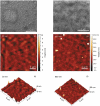A comparative study of the influence of the deposition technique (electrodeposition versus sputtering) on the properties of nanostructured Fe70Pd30 films
- PMID: 32939168
- PMCID: PMC7476512
- DOI: 10.1080/14686996.2020.1780097
A comparative study of the influence of the deposition technique (electrodeposition versus sputtering) on the properties of nanostructured Fe70Pd30 films
Abstract
Sputtering and electrodeposition are among the most widespread techniques for metallic thin film deposition. Since these techniques operate under different principles, the resulting films typically show different microstructures even when the chemical composition is kept fixed. In this work, films of Fe70Pd30 were produced in a thickness range between 30 and 600 nm, using both electrodeposition and sputtering. The electrodeposited films were deposited under potentiostatic regime from an ammonia sulfosalicylic acid-based aqueous solution. Meanwhile, the sputtered films were deposited from a composite target in radio frequency regime. Both approaches were proven to yield high quality and homogenous films. However, their crystallographic structure was different. Although all films were polycrystalline and Fe and Pd formed a solid solution with a body-centered cubic structure, a palladium hydride phase was additionally detected in the electrodeposited films. The occurrence of this phase induced internal stress in the films, thereby influencing their magnetic properties. In particular, the thickest electrodeposited Fe70Pd30 films showed out-of-plane magnetic anisotropy, whereas the magnetization easy axis lied in the film plane for all the sputtered films. The domain pattern of the electrodeposited films was investigated by magnetic force microscopy. Finally, nanoindentation studies highlighted the high quality of both the sputtered and electrodeposited films, the former exhibiting higher reduced Young's modulus and Berkovich hardness values.
Keywords: 105 Low-Dimension (1D/2D) materials; 106 Metallic materials; 203 Magnetics / Spintronics / Superconductors; 301 Chemical syntheses / processing; 303 Mechanical / Physical processing; 306 Thin film / Coatings; 503 TEM; 504 X-ray / Neutron diffraction and scattering; FePd alloy; SEM; STEM; electrodeposition; magnetic properties; mechanical properties; perpendicular magnetic anisotropy; sputtering; stripe domains; thin films.
© 2020 The Author(s). Published by National Institute for Materials Science in partnership with Taylor & Francis Group.
Conflict of interest statement
There are no conflicts to declare.
Figures









References
-
- Chiu YJ, Shen CY, Chang HW, et al. Characteristics of iron-palladium alloy thin films deposited by magnetron sputtering. Results Phys. 2018;9:17–22.
-
- Sun S, Murray CB, Weller D, et al. Monodisperse fept nanoparticles and ferromagnetic fept nanocrystal superlattices. Science. 2000;287(5460):1989–1992. - PubMed
-
- Weller D, Moser A, Folks L, et al. High ku materials approach to 100 gbits/in2. IEEE Trans Magn. 2000. January;36(1):10–15.
-
- Chin TS. Permanent magnet films for applications in microelectromechanical systems. J Magn Magn Mater. 2000;209(1):75–79.
-
- Sharma P, Waki J, Kaushik N, et al. High coercivity characteristics of feptb exchange- coupled nanocomposite thick film spring magnets produced by sputtering. Acta Mater. 2007;55(12):4203–4212.
